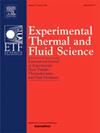强折射流体背景取向纹影条纹跟踪分析
IF 2.8
2区 工程技术
Q2 ENGINEERING, MECHANICAL
Experimental Thermal and Fluid Science
Pub Date : 2025-02-09
DOI:10.1016/j.expthermflusci.2025.111434
引用次数: 0
摘要
背景定向纹影(BOS)是一种测量流体场密度分布的定量方法。目前常用的互相关和傅立叶变换等方法在测量强折射流体时遇到了挑战,表现为背景图案的模糊失真。这个问题是由与模式位移相关的密度梯度的快速变化引起的。为了解决这一问题,我们开发了基于周期条纹模式的BOS条纹跟踪分析方法。通过跟踪背景图中每条完整的条纹并计算其变形,建立了条纹形状与密度分布之间的定量理论关系。该方法在实验室中应用于内波稳定场和动态场的密度测量。通过与电导率探头测量和内波理论的比较,证实了该方法测量大位移梯度流体的准确性。通过建立成像数值模拟,评估了该方法在图像处理中的性能和局限性。结果表明,该方法在密度场测量的有效范围内精度超过5%,具有较强的抗噪声能力。最后给出了测量不同密度场时条纹设计的指导原则。本文提出了一种测量大折射率流体密度变化的有效方法,如强分层流体,以及燃烧和冲击波。本文章由计算机程序翻译,如有差异,请以英文原文为准。
Fringe tracking analysis in background oriented Schlieren for strongly refracting fluids
Background oriented Schlieren (BOS) is a quantitative method for measuring the density distribution of fluid fields. The current commonly used methods such as cross-correlation and Fourier transform encounter challenges when measuring fluids with strong refraction, manifesting as the indistinct distortion of the background patterns. This issue is caused by the rapid changes in density gradients associated with the pattern displacement. To address this problem, we develop the fringe tracking analysis method for BOS based on periodic fringe patterns. We establish a quantitative theoretical relationship between the fringe shape and the density distribution by tracking each complete fringe in the background pattern and calculating their deformation. This method is applied in the laboratory to measure the density of stable and dynamic fields with internal waves. Comparisons with conductivity probe measurements and internal wave theory confirm the method’s accuracy in measuring fluids with large displacement gradients. By establishing an imaging numerical simulation, the performance and limitations of this method in image processing are evaluated. The results show that this method achieves an accuracy exceeding 5% within its effective range for measuring density fields and exhibits robustness against noise. Finally, we provide guidelines for designing fringes in measuring different density fields. This work presents an effective method for measuring density variations in fluids with large refractive index, such as strong stratified fluids, as well as burning and shock waves.
求助全文
通过发布文献求助,成功后即可免费获取论文全文。
去求助
来源期刊

Experimental Thermal and Fluid Science
工程技术-工程:机械
CiteScore
6.70
自引率
3.10%
发文量
159
审稿时长
34 days
期刊介绍:
Experimental Thermal and Fluid Science provides a forum for research emphasizing experimental work that enhances fundamental understanding of heat transfer, thermodynamics, and fluid mechanics. In addition to the principal areas of research, the journal covers research results in related fields, including combined heat and mass transfer, flows with phase transition, micro- and nano-scale systems, multiphase flow, combustion, radiative transfer, porous media, cryogenics, turbulence, and novel experimental techniques.
 求助内容:
求助内容: 应助结果提醒方式:
应助结果提醒方式:


